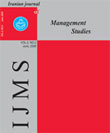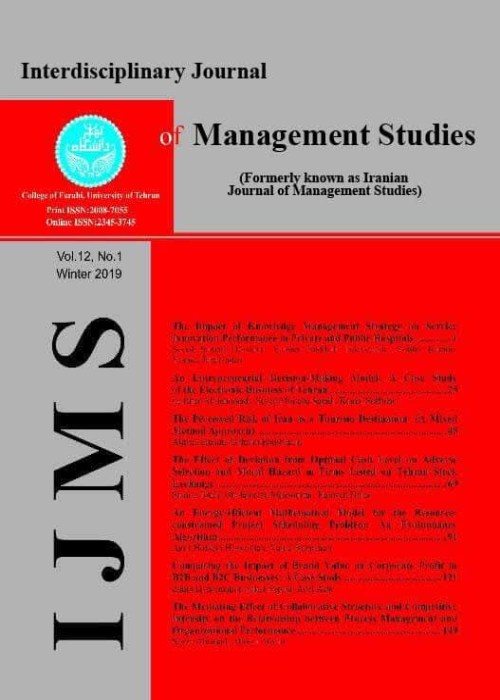فهرست مطالب

Iranian Journal of Management Studies
Volume:2 Issue: 2, Spring 2009
- تاریخ انتشار: 1387/10/11
- تعداد عناوین: 7
-
-
Page 5With rapid changes in the business environment, organizations are increasingly looking at human resources as a unique asset that can provide sustained competitive advantage. As much as, people are viewed among the most important resources to firms, HR strategy would be central to achieve competitive advantages. Firms should view HR strategy as an important tool for integrating competencies inside organization and for matching employment capabilities with organizational strategy, and investigate how various combinations of capabilities can lead to competitive advantage. So, it is believed to be important that the management of the human resources should be in perfect fit with the management of the organization as a whole and its strategic plans. The purpose of this paper is to examine the matching of HR strategy with organizational strategy and HR capabilities in a sample of Iranian firms. In this paper at first by reviewing of related approaches in
-
Page 31Purpose – The purpose of this paper is to present a study of knowledge management understanding and usage in small and medium knowledge-intensive enterprises. Design/methodology/approach – The study has taken an interpretative approach, using two knowledge-intensive South ISFAHAN (Iran) companies as case studies, both of which are characterized by the need to process and use knowledge on a daily basis in order to remain competitive. The case studies were analyzed using qualitative research methodology, composed of interviews and concept mapping, thus deriving a characterization of understandings, perceptions and requirements of SMEs in relation to knowledge management. Findings – The study provides evidence that, while SMEs, including knowledge intensive ones, acknowledge that adequately capturing, storing, sharing and disseminating knowledge can lead to greater innovation and productivity, their managers are not prepared to invest the relatively high effort on long term knowledge management goals for which they have difficulty in establishing
-
Page 57Today, students spend only 10 percent of their time in training centers and the major part of their time is spent in home, society and other places. However, significant events happen in this limited time. In addition to training and learning, they are prepared and educated to interact with society. Education is an important issue in global educating and training systems. There are different approaches in this regard. Some educational systems and connoisseurs believe that training and education are the same but others separate them. It is tried in this article to talk about principles and basics of preventing educational damages especially moral education. Meanwhile, 12 suggested principles and some guidelines are provided. This important subject will be achieved by considering hidden or indirect training.
-
Page 77Purpose – The aim of this study is to examine relation between employees’ participation in the organizations decisions making and their psychological empowerment in Iran Telecommunication Company subsidiary of Mazanderan Province. Design / methodology /approach- 250 employees from the Iran Telecommunication Company subsidiary of Mazanderan Province participated in this study. A Spearman's correlation analysis was used to investigate correlation between participation employees in decision making and psychological empowerment among employees Telecommunication Company of Mazanderan Province. Finding – the findings of this study have shown that higher levels of PDM are associated with significantly higher Competence, Meaningfulness, Impact and Self-determination (p_value>0.05). A significant positive correlation was found between employees’ participation decisions making and total dimension empowerment. Coefficient correlation PDM and empowerment is 0.71 that indictor relation strengthens between two variables.
-
Page 97Observation of justice is one of the most important indexes influencing satisfaction of the personnel of an organization so that perceiving injustice will result in the personnel dissatisfaction thereby leaving negative influence on their performance [38]. This situation also influences the customers’ satisfaction in the service organizations where the personnel have direct and face-to-face contact with customers; particularly perceiving interactional justice from the personnel behavior helps the organization to maintain its customers and provides the grounds for survival and long-term profitability of the organization. Emphasizing the concept of justice and its influence on efficiency of service organizations in obtaining customers’ satisfaction, this article leads us to understand that in addition to a positive relationship between perceiving justice and job satisfaction, there is also a relationship between perceiving justice and customers’ satisfaction; meanwhile personnel are more susceptible to distributive justice than to interactional justice, although the customers are more susceptible
-
Page 115Excellence Synergic Index (ESI) is a new method for the excellence measurement. This technique is a causal method. ESI method was developed for studying the relations and interaction of excellence criteria and organizational pathology. By “ESI”, it is possible to measure the performance excellence of any service enterprises, to diagnosis organizational pathos and to propose problem-solving and weakness-removing methods for service enterprises. The “ESI” method is a self-assessment tool for service and nonprofit enterprises. Stages of ESI are: Determination of affecting score per criterion, Calculation of ESI, Calculation of synergic gaps, Determination of priority attention area (Paa)s, determination of Priority Action Area (PAA)s, provide application solutions for resolve organizational pathos and review.
-
Page 129While the growth of MIS investment and its influence is making MIS evaluation ever more indispensable, little attention has been paid to assessing and communicating system effectiveness. This paper attempts to empirically assess the effectiveness of integrated human resource information system in Iranian oil industry. As suggested by recent research, the widely accepted IS success model is based on end user satisfaction. Therefore, we have examined IS effectiveness through assessing user satisfaction about system quality and information quality of system as well actual System use by DeLone and McLean model. Data from four surveys in four different organizations in Iranian Oil Industry are pooled to explore the end user satisfaction and the degree of using system by these users. The results of surveys show that user satisfaction from information quality, system quality and system use is respectively 0.92, 0.82 and 0.91. Thesrefore, the integrated human resource system has high effectiveness


